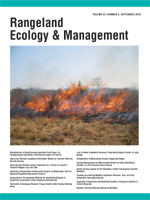Linear disturbances associated with on- and off-road vehicle use on rangelands has increased dramatically throughout the world in recent decades. This increase is due to a variety of factors including increased availability of all-terrain vehicles, infrastructure development (oil, gas, renewable energy, and ex-urban), and recreational activities. In addition to the direct impacts of road development, the presence and use of roads may alter resilience of adjoining areas through indirect effects such as altered site hydrologic and eolian processes, invasive seed dispersal, and sediment transport. There are few standardized methods for assessing impacts of transportation-related land-use activities on soils and vegetation in arid and semi-arid rangelands. Interpreting Indicators of Rangeland Health (IIRH) is an internationally accepted qualitative assessment that is applied widely to rangelands. We tested the sensitivity of IIRH to impacts of roads, trails, and pipelines on adjacent lands by surveying plots at three distances from these linear disturbances. We performed tests at 16 randomly selected sites in each of three ecosystems (Northern High Plains, Colorado Plateau, and Chihuahuan Desert) for a total of 208 evaluation plots. We also evaluated the repeatability of IIRH when applied to road-related disturbance gradients. Finally, we tested extent of correlations between IIRH plot attribute departure classes and trends in a suite of quantitative indicators. Results indicated that the IIRH technique is sensitive to direct and indirect impacts of transportation activities with greater departure from reference condition near disturbances than far from disturbances. Trends in degradation of ecological processes detected with qualitative assessments were highly correlated with quantitative data. Qualitative and quantitative assessments employed in this study can be used to assess impacts of transportation features at the plot scale. Through integration with remote sensing technologies, these methods could also potentially be used to assess cumulative impacts of transportation networks at the landscape scale.
How to translate text using browser tools
1 September 2010
Assessing Transportation Infrastructure Impacts on Rangelands: Test of a Standard Rangeland Assessment Protocol
Michael C. Duniway,
Jeffrey E. Herrick,
David A. Pyke,
David Toledo P.
ACCESS THE FULL ARTICLE
disturbance
indicators
off-highway vehicles
oil and gas
rangeland health
roads





